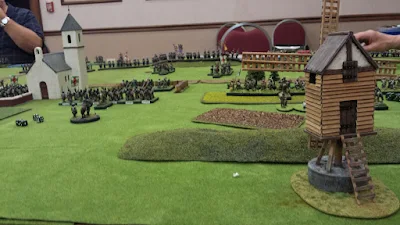 |
| Quite the Affair old boy! |
 |
| Russians enter the table. It's a very long way to The Allies lines! |
 |
| Russian advance |
Defending on parallel ridges the battlefield is mostly open rolling terrain with woods protecting both flanks. The Russian forces (Vladimirski infantry Regiment of 4 battalions, 16th light artillery battery and the Kievski and Ingermanlandski Hussar Regiments) enter the table. The Allies are deployed in three lines. A skirmish line of 1/1st Zouaves face the Russians. Behind them are a battalion of 7th Ligne French line infantry. In the distance, hidden behind a ridge line are British 7th Royal Fusiliers and 23rd Royal Welch Fusiliers. The British Heavy cavalry brigades deployed in The woods. The Russian forces must advance across the field quickly (limited number of moves) and capture the far ridge line while destroying the Allied force. The Allies must stop the Russians. Rules used are "Charge of the Light Brigade." All figures are 25mm.
 |
| Pesky French |
 |
| Russians suffer casualties from the Zouaves skirmish fire. |
The game started with the Russian infantry and artillery advancing onto the table. The cavalry hung back protecting the flanks as British cavalry were rumored to be in the area. The Russians used a command point each per battalion and artillery to try and contact the French, but bad die rolls left them short. The pesky French pounded them with long range rifle fire while they fell back to join their brother battalion on the ridge.
Although suffering long range casualties the Russian advance pushed the French back into the first ridge line. Here their cavalry deployed into double lines to advance and take the French line in a double envelopment.
 |
| Heavy Brigade destroyed Russian Cavalry Regiment |
But, out of the wood line where they were hidden came the British Heavy cavalry brigade which crashed into the Russian cavalry. Caught in flank the Russian cavalry not only lost the melee and retreated but their commander was killed! (for every three 6's rolled you check for a leader being wounded or killed).
The Russians infantry continued their advance but the right hand battalion formed line facing the British cavalry and their artillery deployed into firing line. Their work done the French double moved back towards their British allies while the Heavy brigade covered their retreat.
Having cleared the first ridge, the Russian commander sorted his line out and brought up his battery for the final push. But his left flank cavalry commander, seeing the retreating Zouaves in the open could not contain himself and charged headlong towards them. This brought him into rifle range of not only the Zouaves, but the British on the hill. The rifle fire decimated the cavalry, which lost over half its strength and retired.
 |
| Russian cavalry charging the French |
 |
| Taking aim at all those horse! |
Both sides reformed in their ridge lines. Although the Russian commander finally unlimbered his battery he did not have the time to batter the Allies. He knew could get one or two fires into them before he had to advance. He managed to remove a stand of the Zouaves with his artillery fire.
Advancing across the open fields, the Russian columns were again brought under heavy rifle fire. The reformed Russian cavalry advanced to support the infantry.
But this time the allies had double the battalions they had earlier. Each battalion picked out a advancing column. Two of the Russian columns were shot up and had to retire. At this point the Heavy brigade attacked and drove off the remaining Russian cavalry.
The French charged off the ridge to attack the Russians while the British advanced against the remaining Russian battalion.
 |
| French chasing routing Russian line. |
 |
| Fusiliers brigade move against a isolated Russian battalion. |
At this point, with the Russians in disarray and routing the Allied commanders met to congratulate themselves in the victory. The Russian commanders met to think up how to write this up as a victory. Or not get thrown out of upper stories windows in tall buildings.
One of the most interesting battles of the Rev War was Cowpens which the reader may have guessed what was really being played here. A problem with re fighting any historical battle is you know what happened. I decided to not tell thus to the players. So here, the players thought they were fighting the battle of Little Inkerman (26 October 1854) but we're really fighting the Cowpens battle. As a game it worked well and surprisingly mimicked the historical battle very well.
This was a small, but enjoyable game. It was great fun to get my Crimean collection out again, and great fun to play "Charge of the Light Brigade" rules again. Couple things about the period are getting to have British and French fight together on the same side and seeing masses of Russians in overcoats. The rules are great fun and I enjoy them very much. They create a fun game that moves fast and mirrors the period very well. Sadly they are not more widely available. I will post a rules review of them soon, and anyone who is interested in a set please send me a email and I will attach them.






























